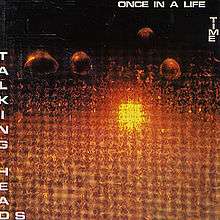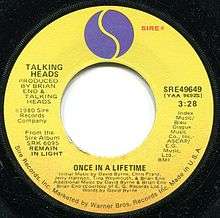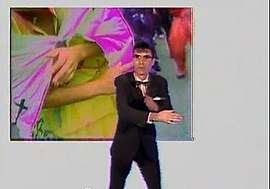Once in a Lifetime (Talking Heads song)
"Once in a Lifetime" is a song by the American rock band Talking Heads, produced and cowritten by Brian Eno. The lead single from Talking Heads' fourth studio album, Remain in Light (1980), it was released on February 2, 1981, through Sire Records.
| "Once in a Lifetime" | ||||
|---|---|---|---|---|
 Cover art of UK 7" and 12" vinyl singles | ||||
| Single by Talking Heads | ||||
| from the album Remain in Light | ||||
| B-side |
| |||
| Released | February 2, 1981 | |||
| Recorded | July – August 1980 | |||
| Genre | ||||
| Length | 4:19 | |||
| Label | Sire | |||
| Songwriter(s) | ||||
| Producer(s) | Brian Eno | |||
| Talking Heads singles chronology | ||||
| ||||
| ||||
| Alternative release | ||||
 A-side label of US vinyl single | ||||
| Music video | ||||
| "Once in a Lifetime" on YouTube | ||||
| Audio | ||||
| "Once in a Lifetime" on YouTube | ||||
Eno and Talking Heads developed "Once in a Lifetime" through extensive jams, inspired by Afrobeat musicians such as Fela Kuti. David Byrne's lyrics and vocals were inspired by preachers delivering sermons. The music video, co-directed by Toni Basil, has Byrne dancing erratically over footage of religious rituals.
"Once in a Lifetime" was certified silver in the UK in 2018. A live version, taken from the 1984 concert film Stop Making Sense, charted in 1986 on the Billboard Hot 100. NPR named "Once in a Lifetime" one of the 100 most important American musical works of the 20th century. The Rock and Roll Hall of Fame lists it as one of the "500 Songs that Shaped Rock and Roll".
Production
Like other songs on Remain in Light, Talking Heads and producer Brian Eno developed "Once in a Lifetime" by recording jams, isolating the best parts, and learning to play them repetitively.[3] Songwriter Robert Palmer joined the jam on guitar and percussion.[3] The technique was influenced by early hip hop and the Afrobeat music of artists such as Fela Kuti, which Eno had introduced to the band. Singer David Byrne likened the process to modern looping and sampling, describing the band as "human samplers".[3] He said the song was a result of the band trying and failing to play funk, inadvertently creating something new instead.[3]
The track was initially not one of Eno's favorites, and the band almost abandoned it. According to keyboardist Jerry Harrison, "Because there were so few chord changes, and everything was in a sort of trance ... it became harder to write defined choruses."[4][5] However, Byrne had faith in the song and felt he could write lyrics to it. Eno developed the chorus melody by singing wordlessly, and the song "fell into place".[3] Harrison developed the "bubbly" synthesizer line and added the Hammond organ climax, taken from the Velvet Underground's "What Goes On".[4]
Eno interpreted the rhythm differently from the band; he interpreted the third beat of the bar as the first. He encouraged the musicians to interpret the beat in different ways, thereby exaggerating different rhythmic elements.[4] According to Eno, "This means the song has a funny balance, with two centers of gravity – their funk groove, and my dubby, reggae-ish understanding of it; a bit like the way Fela Kuti songs will have multiple rhythms going on at the same time, warping in and out of each other."[3]
According to bassist Tina Weymouth, her husband, drummer Chris Frantz, created the bassline by yelling during a jam, which she mimicked on bass guitar.[4] She wanted to "leave lots of space for the cacophony that surrounded me. I felt like I was pounding away like a carpenter, just nailing away to get it in the groove."[3] Eno wanted to remove the first note in the bassline, as he felt it was too "obvious", and rerecorded the part himself. When the band returned to New York and Eno had gone home, the engineer asked Weymouth to record the bassline again. She said: "It wasn't a big fight between me and Brian, as it has sometimes been portrayed, it was just a musical dispute."[3]
Lyrics
Byrne improvised lines as if he were giving a sermon, with a call-and-response chorus like a preacher and congregation. His vocals are "half-spoken, half-sung", with lyrics about living in a "beautiful house" with a "beautiful wife" and a "large automobile".[6][7]
Guardian writer Jack Malcolm suggested that the song can be read "as an art-pop rumination on the existential ticking time bomb of unchecked consumerism and advancing age".[7] According to AllMusic critic Steve Huey, the lyrics address "the drudgery of living life according to social expectations, and pursuing commonly accepted trophies (a large automobile, beautiful house, beautiful wife)".[6] Although the singer has these trophies, he questions whether they are real and how he acquired them, a kind of existential crisis.[8]
Byrne denied that the lyrics address yuppie greed and said the song was about the unconscious: "We operate half-awake or on autopilot and end up, whatever, with a house and family and job and everything else, and we haven't really stopped to ask ourselves, 'How did I get here?'"[4]
Music video

In the "Once in a Lifetime" music video, Byrne appears in a large, empty white room, dressed in a suit, bowtie and glasses. In the background, inserted via bluescreen, footage of religious rituals or multiple Byrnes appear. Byrne dances erratically, imitating the movements of the rituals and moving in "spasmic" full-body contortions. At the end of the video, a "normal" version of Byrne appears in a black room, dressed in a white, open-collared shirt without glasses.[9]
The video was choreographed and co-directed by Toni Basil. She and Byrne studied archive footage of "preachers, evangelists, people in trances, African tribes, Japanese religious sects" to see how Byrne could incorporate them into his performance.[3] Televangelist Ernest Angley was another inspiration.[10] According to Basil, "David kind of choreographed himself. I set up the camera, put him in front of it and asked him to absorb those ideas. Then I left the room so he could be alone with himself. I came back, looked at the videotape, and we chose physical moves that worked with the music. I just helped to stylize his moves a little."[3] To emphasize Byrne's jerky movements, Basil used an "old-fashioned" zoom lens. The video was made on a low budget; Basil described it as "about as lo-tech as you could get and still be broadcastable".[3]
Release
"Once in a Lifetime" peaked at No. 14 on the UK Singles Chart[11] and at No. 31 in the Dutch singles chart.[12] On 19 January 2018, the single was certified silver for 200,000 copies sold in the United Kingdom.[13] A live version, taken from the 1984 concert film Stop Making Sense, charted in early 1986, reaching No. 91 on the US Billboard Hot 100.[14] An early version of "Once in a Lifetime", "Right Start", was released on the 2006 Remain in Light reissue.[7]
Legacy
In 1996, the Muppet character Kermit the Frog performed the song on an episode of Muppets Tonight. Kermit appears in Byrne's "big suit" and mimics Byrne's dances from Stop Making Sense.[15] In 2016, Guardian writer Malcolm Jack wrote: "'Once in a Lifetime' is a thing of dizzying power, beauty and mystery ... it sounds like nothing else in the history of pop."[7] In 2000, NPR named "Once in a Lifetime" one of the 100 most important American musical works of the 20th century.[16] The Rock and Roll Hall of Fame lists it as one of the "500 Songs that Shaped Rock and Roll".[17] In 2003, BBC critic Chris Jones wrote: "[The] hilarious video for "Once in A Lifetime", with David Byrne's twitchy Middle American preacher in horn rims, remains as compelling as it was in 1981. And how many other videos can you say that about?"[18] Appearing on NPR's All Songs Considered, musician Travis Morrison selected "Once in a Lifetime" as a "perfect song", saying: "The lyrics are astounding – they are meaningless and totally meaningful at the same time. That's as good as rock lyrics get."[19]
Personnel
Talking Heads
- David Byrne – lead vocals, guitar
- Jerry Harrison – synthesizer, organ, backing vocals
- Tina Weymouth – bass, backing vocals
- Chris Frantz – drums
Additional personnel
Charts
| Chart (1981) | Peak position |
|---|---|
| Australian Singles Chart[21] | 23 |
| Canadian Singles Chart[22] | 28 |
| Dutch Singles Chart[12] | 24 |
| Irish Singles Chart | 16 |
| UK Singles Chart[11] | 14 |
| US Billboard Bubbling Under the Hot 100[23] | 103 |
| Chart (1985) | Peak position |
|---|---|
| Dutch Singles Chart[12] | 22 |
| New Zealand Singles Chart[24] | 15 |
| US Billboard Hot 100[23] | 91 |
References
- Huey, Steve. "Once In a Lifetime - Talking Heads". AllMusic. Retrieved November 7, 2017.
- Potton, Ed (August 15, 2015). "David Byrne: composer, curator, cyclist — not just a Talking Head". The Times. Retrieved February 28, 2016.
- Lewis, John (November 2007). "The Making Of... Once in a Lifetime by Talking Heads". Uncut.
- ""Once in a Lifetime" National Public Radio broadcast, March 27, 2000". NPR. Retrieved April 7, 2018.
- "The 100 most important American musical works of the 20th century". NPR. Retrieved April 7, 2018.
- Huey, S. "Once in a Lifetime". AllMusic. Retrieved March 30, 2014.
- Jack, Malcolm (September 21, 2016). "Talking Heads – 10 of the best". the Guardian. Retrieved March 20, 2018.
- Gittens, I. (2004). Talking Heads: Once in a Lifetime: the Stories Behind Every Song. Hal Leonard. pp. 68–71. ISBN 9780634080333.
- "Ridiculously Awesome Music Videos: The Heads' "Once in a Lifetime"". Consequence of Sound. November 25, 2008. Retrieved March 20, 2018.
- Bowman, David (2001). This must be the place: the adventures of Talking Heads in the 20th century (1st ed.). New York: Harper Entertainment. pp. 201. ISBN 0061955981. OCLC 651051467.
- "The Official Charts Company – Talking Heads". Official Charts Company. Retrieved August 13, 2011.
- "Discografie Talking Heads". Dutchcharts.nl (in Dutch). Retrieved August 13, 2011.
- "BRIT Certified". British Phonographic Industry. Enter Once in a Lifetime in the field Search and press Enter.
- "The Hot 100: Week of May 3, 1986". Billboard.com. Retrieved April 28, 2015.
- Blevins, Joe. "Kermit The Frog gets existential with this Talking Heads cover". AV Club. Retrieved March 26, 2018.
- Karr, Rick (March 27, 2000). "The 100 Most Important American Musical Works of the 20th Century". NPR. Retrieved February 12, 2016.
- "The Songs That Shaped Rock and Roll". Rock and Roll Hall of Fame. Archived from the original on January 2, 2016. Retrieved April 9, 2018.
- Jones, Chris (November 17, 2003). "Music - Review of Talking Heads - Once In A Lifetime". BBC. Retrieved February 12, 2016.
- "Perfect Song: Artist Picks". All Songs Considered. NPR. Retrieved May 5, 2018.
- "Once in a Lifetime - Talking Heads - Credits - AllMusic". AllMusic. Retrieved April 7, 2018.
- "Discography Talking Heads". Australian-charts.com. Retrieved August 13, 2011.
- "Talking Heads Top Singles positions". RPM. Archived from the original on September 21, 2011. Retrieved August 13, 2011.
- "Talking Heads > Charts & Awards > Billboard Singles". Allmusic. Retrieved August 13, 2011.
- "Discography Talking Heads". charts.nz. Retrieved August 14, 2011.